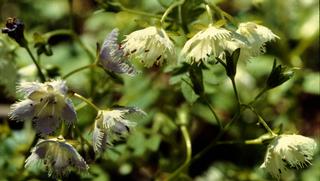Phacelia fimbriata M.
Author: Shawn Kuriger
Undergraduate Ecol 3500
University of Georgia
Athens
back
to genus page
back to family page
Common Names:
The Phacelia fimbriata is also known as
the Fringed Phacelia or the Fringed Scorpion-Weed.
Higher Taxa:
- Class: Dicotyledonous (
Exogenous Plants)
embryo with two or more opposite
cotyledons
- Subclass: Asteridae
- Order: Hydrophyllaceae
- Family: Hydrophyllaceae
The Family Hydrophyllaceae contains
about 18 genera and at least species of plants. It
consists of herbs and small shrubs.
Identification:
Authority: Michaux
The following are
defining characteristics of the P. fimbriata:
- Flowers: white to pale lilac
about 1/2" (1.3 cm) wide; bell-shape corolla
with 5 spreading fringed lobes (hence the
common name Fringed Phacelia)
- Flowering: May-June
- Stem: week, about 6"
tall with little hairs standing straight out
- Leaves: generally white with
broad lobes, cut into 5-9 unequal blunt-tipped
segments, about 2" (5 cm) long, the upper
leaves are unstalked, lower ones stalked
- Habitat: rich woods and
along streams in the mountains.
- Height: 8-16" (20-40
cm)
- Location (museum or herbarium)
where deposited: There are some specimens
of the P. fimbriata deposited at the
University of Georgia herbarium. Most of
the specimens are from Tennessee, North Carolina,
and Virginia.
- Scientific reference: Miami-Mist P.
Purshii
Phacelia fimbriata
(M.)
|
| AREA |
STATUS |
REFERENCES |
North America:
Continental United States; Canada |
YES |
(Small 1933) |
Eastern North America:
United States east of Mississippi;
Ontario and easter Canada |
YES |
(Small 1933) |
Southeastern United States:
AL AR DE DC FL GA KY MD NC TN VA WV |
Yes |
(Small 1933) |
Southern Appalachian States:
AL GA KY NC TN VA WV |
Yes |
(Radford, Ahles, and Bell,
1964)
|
| |
| Coastal Plain |
No |
(Small 1933) |
| Blue Ridge Mountains |
Yes |
(Small 1933) |
- Great Smoky Mountains National Park
|
Yes |
(Campbell, Hutson
and Sharp, 1970) |
| Ridge and Valley |
Yes |
(Small 1933) |
| Cumberland Plateau |
No |
(Small 1933) |
| Georgia |
No |
UGA Herbarium |
| Clarke County,Georgia |
NO |
UGA Herbarium |
Natural History:
Phacelia, a native to North America and Andean South America,
is the largest genus of the Hydrophyllaceae family. Genus Phacelia
comes from the Greek phakelos "a fascicle" which refers
to the clustered flowers it produces. There are about 200
species within the Phacelia genus. This species was
cultivated as garden plants. Unlike the other species of
Phacelia, the P. fimbriata does not have an English
name. Scorpion-weed refers to the odor which smells like
the the inflorescence of the scorpion. This annual species
has nectar-rich flowers which attract bees and other other
insects.
How to Encounter:
The
Fringed Scorpion-weed grows in large beds within rich woods and
near streams in the mountains. The optimal time for viewing
the flower is between May and June. One location for
viewing this spring wildflower is the entrance to Chimney's
Campground in the Great Smoky Mountains. Another prime place to
spot the P. fimbriata is on the banks of the Watauga
River.
Grandfather
Mountain - Linville, NC - Fringed Phacelia
References
Campbell, Carlos C., William F. Hutson, Aaron J. Sharp.
1970. Great Smoky Mountains Wild Flowers. 3rd
ED. The University of Tennesse Press. page 42.
Duncan, Wilbur H. and John T. Kartesz. 1981. Vascular
Flora of Georgia. The Universtiy of Georgia Press.
Athens, GA. page 109.
Gray, Asa M.D. 1848. The Botany of the Northern
United States. James Munroe & Co.
London. page340.
Grimm, William Carey. 1993. Wildflowers and Shrubs.
Stackpole Books. pages 224-227.
Knopf, Alfred A. 1979. The Audubon Society Field to
North American Flowers. William A. Niering & Nacy C.
Olmstead. page 643.
Radford, A. E., H. E. Ahles & C. R. Bell. 1968. Manual
of the Vascular Floraof the Carolinas. University of
North Carolina Press. Chapel Hill, NC. pages 876-878.
Small, John Kunkel. 1933. Manual of the Southeastern Flora.
John Kunkel Small. page 1098.
Steeve, Ed William, and Harol William Ricket. Wild
Flowers of the United States vol 2. McGraw-Hill Book
Co. New York. pages 416-417.
